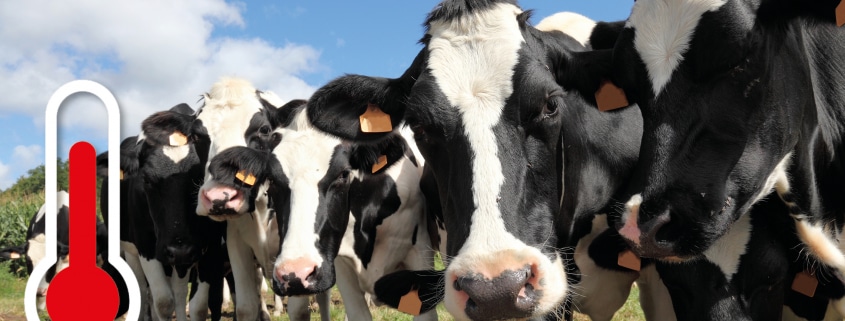How some cows can give heat stress the cold shoulder
Some cows are cooler than others in the face of summer heat. What is their secret to resist heat stress? Scientists are beginning to discover that resilience plays an important role in dairy cows, when it comes to coping with rising temperatures.
by Gwendolyn Jones, Product Manager Gut Agility Activators
Climate change drives research into heat stress
As June approaches temperatures are rising and so is the risk for heat stress in cows. Temperatures are rising, not just now, because we are at the end of May, but also in general. Our climate is changing, and we can expect to see increases in temperature over the coming century. According to recent predictions, global temperatures are expected to rise by 1.4–3.0°C by the end of this century. Not surprisingly several large-scale research projects are currently under way in different parts of the world for a better understanding of heat stress in cattle and more importantly to find ways of managing it more effectively. The goal being to maintain cow welfare, health and productivity in a sustainable way as temperatures rise. Strategies to mitigate heat stress include physical protection, nutritional management and more recently the potential for genetic improvement in heat tolerance is researched.
Milk yield and quality spoils with heat stress
Heat-stressed dairy cows produce less milk and the quality of their milk is reduced. On top of that heat stress can interfere with the cow’s ability to conceive and can increase susceptibility to disease. This can lead to significant economic losses. Consequently, there is considerably incentive to increase the capacity of dairy cows to maintain productivity and fitness in the face of stresses associated with climate change to support food security.
Science turns to resilience for heat tolerance
Several research groups across the world, for example in the UK, India, United States and Australia are researching the challenge of enhancing the resilience of livestock to climatic variability and climate change. They all essentially agree that animal agriculture’s adaptation to climate change should involve technological advances for climate resilient animals. However, continued selection for greater performance in the absence of consideration for heat tolerance will result in greater susceptibility to heat stress.
Scientists at the University of Armidale claim that for the concept of resilience the animal’s reactions with its environment are central. They characterise resilience as the capacity of the animal to return rapidly to its pre-challenge state following short-term exposure to a challenging situation. Therefore, resilience is a comparative measure of differences between animals in the impact of a challenge. Resilience can arise due to lower sensitivity or better adaptability to the challenge. Thus, resilience relies particularly on the reaction of the animal to stressors. Since, stress responses increase disease susceptibility, improving resilience of farm animals could also provide benefits for their health.
At the cellular level, acute environmental change initiates a “heat shock” or cellular stress response. Changes in gene expression associated with a reaction to an environmental stressor involves acute responses at the cellular level as well as changes in gene expression across a variety of organs and tissues associated with the acclimation response.
Gene expression profiling belongs to novel the approaches to identify higher number of transcripts and pathways related to stress tolerance mechanisms. It is known that genes reacting to a certain stress differ between organisms, species, breeds and even genotypes. The differences show in more efficient stress signal perception and transcriptional changes that can lead to successful adaptive response and adaptations and eventually further tolerance. Newer genomics approaches like next-generation sequencing (NGS) hold great promise for accelerating search for genes related to heat tolerance-related traits. NGS has been used to study variants in cattle to identify genes that contribute to heat tolerance.
Cows love a good on-off sprinkle
Of course, also physical strategies to help reduce heat stress are continuously being evaluated and improved. One of the most effective methods of cooling cows during summer is the use of water sprinklers. When given the choice, cows spend more and more time under sprinklers as the ambient temperature rises. Not having the sprinklers on continuously is more effective in terms of cooling cows, and it also helps to conserve water. The sprinklers should cycle on and off to wet cows and then let them dry off. Cooling is more effective if cows are soaked to the skin during the on time and then evaporative cooling occurs during the off time with fan air. Sprinkler and fan cooling resulted in lower body temperatures and respiration rates, improved dry matter intake and milk yield. However, sprinklers are not recommended in environments where relative humidity could reach over 75% due to the increase in humidity associated with these systems.
by Gwendolyn Jones, 2019
Related articles
Case- study – Using real-time data on heat stress risk in dairy field trials



